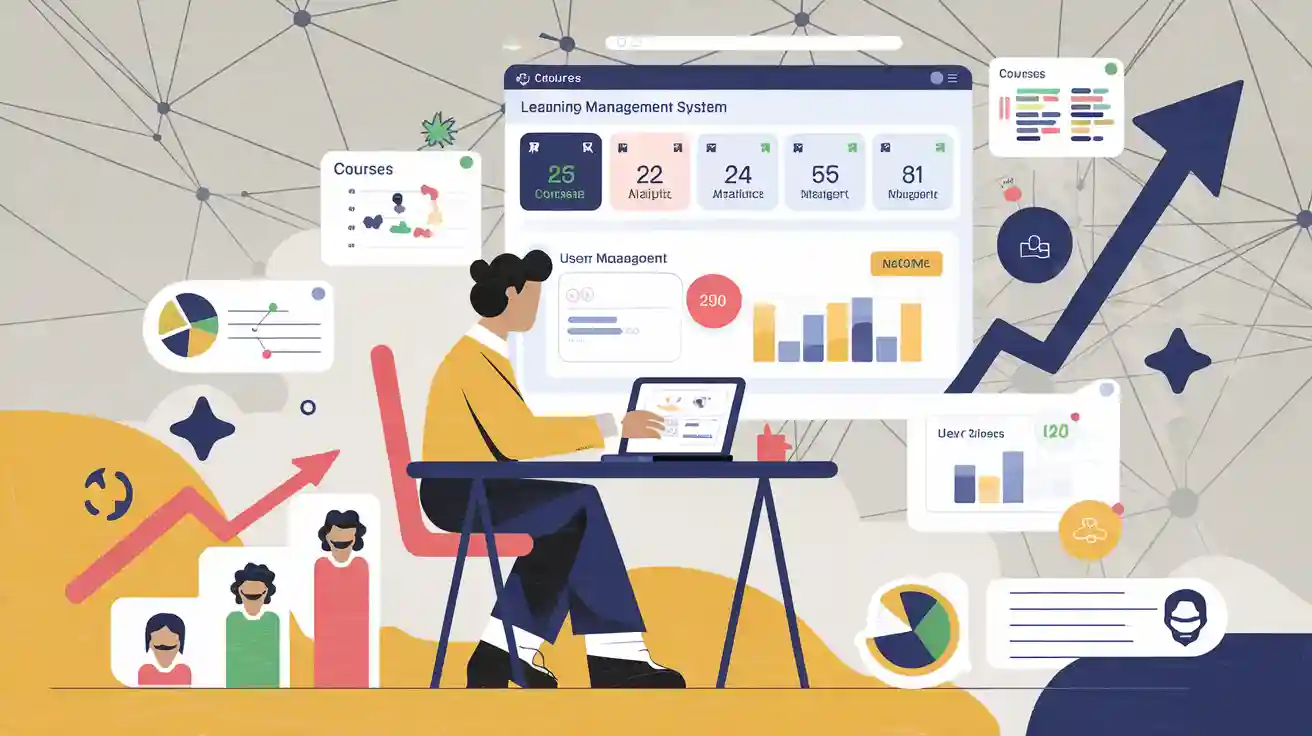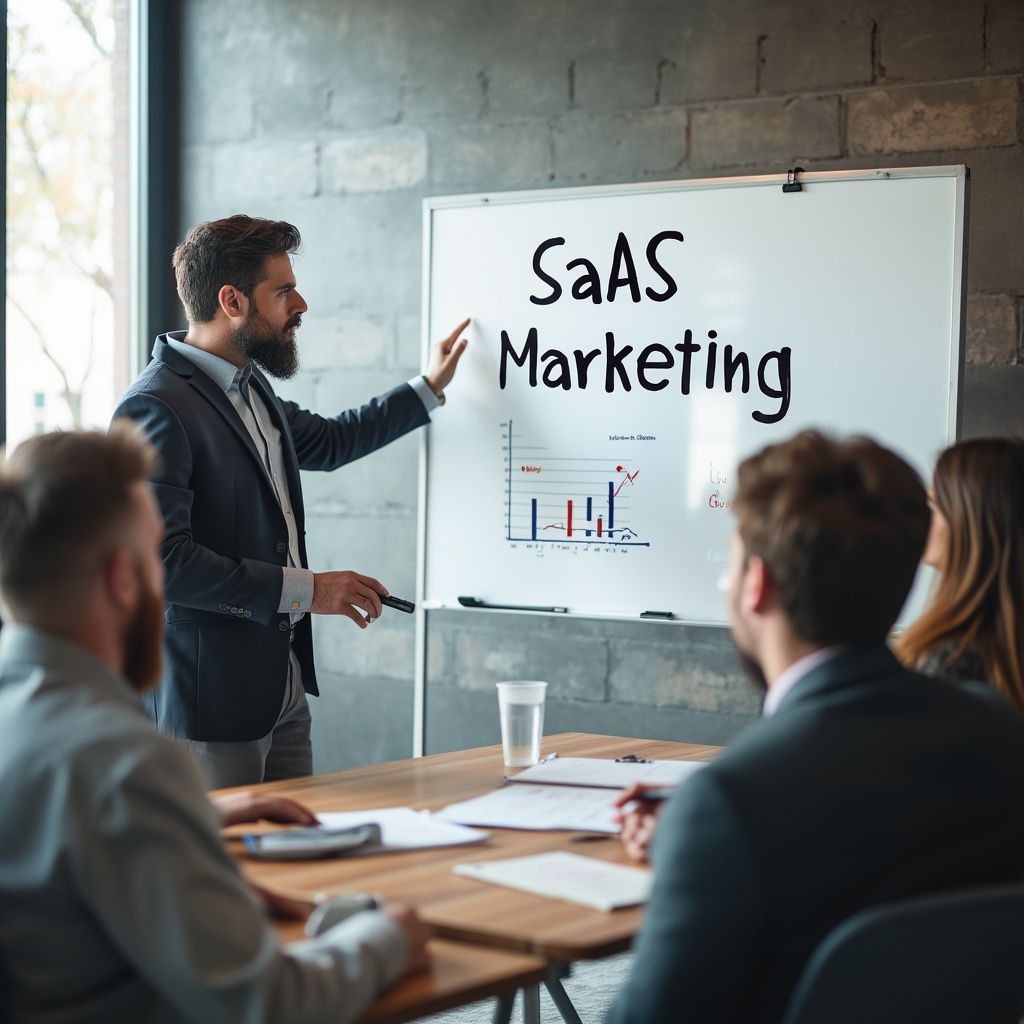
Implementing a SaaS LMS offers businesses a strategic advantage in attracting and retaining clients. A well-designed learning platform simplifies client onboarding, ensuring customers quickly understand and adopt your product. Research shows that acquiring new customers costs five times more than retaining existing ones, and improving retention rates by just 5% can lead to profit increases of up to 95%. Through leveraging a SaaS LMS, you can enhance client satisfaction through customized training modules, making it easier for clients to achieve their goals. This approach fosters loyalty and positions your business as a trusted partner in their success.
What is a SaaS LMS?
Definition and Overview
A SaaS LMS, or Software-as-a-Service Learning Management System, is a cloud-based learning platform designed to streamline the delivery, management, and tracking of educational or training programs. Unlike traditional software that requires installation on local servers, a SaaS LMS operates entirely online, offering flexibility and scalability for businesses of all sizes. This type of platform enables you to provide seamless training experiences to clients, employees, or partners without the need for extensive IT infrastructure.
The growing popularity of SaaS LMS solutions reflects their effectiveness. The global learning management system market is projected to grow from $22.1 billion in 2023 to $51.9 billion by 2028, with a compound annual growth rate (CAGR) of 18.6%.
This rapid expansion highlights the increasing demand for cloud-based learning platforms that cater to modern business needs.
SaaS LMS vs. Traditional LMS
When comparing SaaS LMS to traditional LMS systems, the differences in usability, adaptability, and performance become clear. SaaS LMS platforms excel in providing a structured yet flexible learning environment. They incorporate modern learning trends, such as gamification and mobile accessibility, which enhance user engagement. On the other hand, traditional LMS systems often struggle to keep learners engaged due to outdated features and limited customization options.
Administrative control is another area where SaaS LMS stands out. Tasks like monitoring progress, generating reports, and tracking compliance are simplified with advanced tools. Traditional systems may lack these comprehensive features, making them less efficient for businesses aiming to scale their training programs.
For example, a SaaS LMS tailored for the healthcare sector effectively addresses compliance with HIPAA regulations. Features like automated reminders, real-time progress tracking, and audit trails make it a preferred choice for hospitals and clinics. These capabilities demonstrate how SaaS LMS platforms adapt to industry-specific needs, offering a significant advantage over traditional systems.
|
Feature/Characteristic |
SaaS LMS |
Traditional LMS |
|---|---|---|
|
User Engagement |
High engagement with innovative features |
Often struggles to engage learners |
|
Administrative Control |
Simplifies tasks like monitoring and reporting |
May lack comprehensive administrative tools |
|
Learning Environment |
Structured and flexible |
Standardized but less engaging |
|
Compliance Tracking |
Advanced features for compliance |
Limited engagement beyond compliance |
|
Adaptability |
Incorporates modern learning trends |
Often outdated in features |
Benefits of SaaS LMS for Client Acquisition
Streamlined Onboarding
A SaaS LMS simplifies the onboarding process for your clients, ensuring they quickly adapt to your product or service. With a cloud-based platform, you can create structured learning paths that guide users step-by-step through essential features and functionalities.
This approach reduces the time it takes for clients to become proficient, enhancing their overall experience.
Automated features like progress tracking and reminders ensure clients stay on schedule during onboarding. You can also customize the content to align with your brand, making the learning process more engaging and relevant. A streamlined onboarding experience boosts client satisfaction and sets the foundation for long-term loyalty.
Enhanced Client Training
Effective client training is critical for building confidence and independence. A SaaS LMS allows you to deliver tailored training programs that address specific client needs. Interactive modules, quizzes, and gamified elements keep clients engaged, ensuring they retain the information they need to succeed.
Data shows that 68% of clients use a product more effectively after training, while 56% explore additional features and functions. Furthermore, 87% feel more independent and require less support. These outcomes highlight the importance of investing in a robust training system.
Empowering your clients through learning reduces their reliance on customer support and fosters a stronger relationship.
|
Metric |
Percentage |
|---|---|
|
Clients using a product more effectively |
68% |
|
Clients exploring additional features |
56% |
|
Clients feeling independent and needing less support |
87% |
Improved Product Adoption
A well-implemented SaaS LMS drives product adoption by educating clients on how to maximize the value of your offerings. Clients who understand your product’s full potential are more likely to integrate it into their daily operations. This leads to higher engagement and satisfaction.
Customer education plays a pivotal role in improving product adoption and retention. Key metrics such as course completion rates and product usage statistics reflect the success of your training initiatives. A confident and well-informed client base is more likely to remain loyal and advocate for your brand. Effective training programs also enhance the overall customer experience, fostering long-term success for you and your clients.
-
Customer education enhances product adoption and retention.
-
Metrics like course completion rates and product usage reflect training success.
-
Confident clients are more likely to remain loyal and advocate for your brand.
-
Well-designed programs improve customer experience and engagement.
Scalability for Business Growth
Scalability is critical when choosing a learning management system (LMS) for your business. As your organization grows, your training and onboarding needs will expand. A SaaS LMS ensures that your learning platform can adapt to these changes without causing disruptions. Unlike traditional systems, a scalable LMS allows you to add users, courses, and features effortlessly, ensuring your operations remain smooth during periods of growth.
Businesses that fail to adopt scalable solutions often face challenges. Over 30% of companies without scalable LMS platforms experience disruptions in their training and onboarding processes. These interruptions can lead to delays, reduced client satisfaction, and missed opportunities.
On the other hand, organizations using scalable LMS platforms report a 65% improvement in onboarding effectiveness. This demonstrates how a SaaS LMS can directly contribute to your business’s success. A SaaS LMS also supports your business by offering flexible pricing models. You can scale your subscription plan based on your current needs, avoiding unnecessary expenses. This flexibility ensures that you only pay for what you use, making it a cost-effective solution for businesses of all sizes. Additionally, cloud-based infrastructure ensures that your LMS remains accessible and functional, even as your user base grows.
Step-by-Step Guide to Implementing SaaS LMS
Identify Business Needs
The first step in implementing a SaaS LMS is understanding your business’s unique requirements. Start by evaluating your current training and learning processes. Identify gaps that hinder employee development or client onboarding. Consider the specific goals you want to achieve with the platform, such as improving product adoption, streamlining onboarding, or enhancing compliance training.
Forming an implementation team is crucial at this stage. Include representatives from different departments, such as HR, IT, and training, to ensure all perspectives are considered. Collaborate with the LMS vendor to align their expertise with your organizational needs. Defining key performance indicators (KPIs) will help you measure the success of the implementation. For example, track metrics like course completion rates, user engagement, and time-to-productivity for new employees or clients.
Choose the Right SaaS LMS Platform
Selecting the right SaaS LMS platform is critical to achieving your goals. Compare platforms based on features, scalability, and cost-effectiveness. A SaaS LMS offers advantages like cloud-based accessibility, vendor-managed updates, and seamless integration capabilities.
These features make it a more flexible and scalable option compared to hosted LMS solutions.
|
Feature |
SaaS LMS |
Hosted LMS |
|---|---|---|
|
Installation |
Managed on cloud servers |
Requires on-premise hardware |
|
Maintenance and Updates |
Vendor handles updates |
Requires in-house maintenance |
|
Integration Capabilities |
APIs for seamless integration |
Limited without extensive development |
|
Scalability |
Easily scalable |
Limited by hardware capacity |
When evaluating platforms, prioritize those that align with your business needs. Look for features like mobile accessibility, analytics, and customization options. Ensure the platform supports third-party integrations to connect with existing tools like CRM or HR systems. A detailed implementation strategy, including a timeline and milestones, will help you stay on track.
Customize the LMS for Your Brand
Customizing the SaaS LMS ensures it reflects your brand identity and meets user expectations. Start by tailoring the interface with your company’s logo, colors, and messaging. This creates a cohesive experience for employees and clients, reinforcing your brand image.
Try to develop course content that aligns with your training objectives. Use interactive elements like quizzes, videos, and gamification to engage users. Ensure the content is compatible with the platform and optimized for mobile devices.
Setting up user profiles and permissions will help you manage access and track progress effectively. Prepare for data migration by cleaning up existing records and mapping them to the new system. Upload content in phases to test compatibility and functionality. An engagement plan, including user training and support resources, will encourage adoption and maximize the platform’s impact.
Train Your Team
Training your team is a critical step in successfully implementing a SaaS LMS. A well-prepared team ensures smooth adoption and maximizes the platform’s potential. Start by identifying key team members who will manage and support the LMS. These individuals should understand the platform’s features and how it aligns with your business goals. Provide comprehensive training sessions tailored to different roles. For example, administrators need to learn how to manage user accounts, monitor progress, and generate reports. End-users, such as employees or clients, should focus on navigating the platform and completing learning modules.
Interactive sessions, hands-on practice, and Q&A opportunities can enhance understanding and engagement.
SaaS LMS platforms offer robust analytics and reporting tools that help you measure the impact of training initiatives. These tools track learner progress, course completion rates, and knowledge assessments. For instance, data tracking can reveal how training programs reduce churn through improved customer education. Effective sales enablement training often leads to increased close rates. Use these insights to refine your training strategies and align them with organizational objectives.
Encourage ongoing learning by creating a culture that values skill development. Regularly update training materials to reflect changes in your products or services. This approach keeps your team informed and ensures they can provide the best support to clients.
Launch and Monitor Performance
Launching your SaaS LMS requires careful planning and execution. Begin by rolling out the platform to a small group of users. This pilot phase allows you to identify potential issues and gather feedback. Addressing these concerns before a full-scale launch ensures a smoother experience for all users.
Monitoring performance during the launch phase is essential. Key metrics provide valuable insights into the platform’s effectiveness. For example, adoption rates measure how many users engage with the LMS, while stickiness tracks repeat usage. Growth metrics compare new users to those who abandon the platform, highlighting areas for improvement. Engagement metrics, such as time spent and session length, reveal how users interact with the platform.
|
Metric |
Description |
|---|---|
|
Adoption |
Count of how many learners have used the LMS, benchmarked by use case and demographics. |
|
Stickiness |
Measure of repeat users returning to the LMS for various offerings. |
|
Growth |
Comparison between new users and those who have abandoned the LMS. |
|
Engagement |
Measure of user interaction, including time spent and session length. |
|
Course Effectiveness |
Analysis of completion rates, test scores, and feedback to assess if learning objectives are met. |
|
System Performance |
Monitoring uptime, speed, and technical issues to ensure a seamless user experience. |
Use these metrics to identify strengths and weaknesses in your LMS implementation. For example, low engagement might indicate the need for more interactive content or better user support. Regularly review system performance to address technical issues promptly.
A seamless user experience builds trust and encourages continued use of the platform.
After the launch, maintain open communication with users. Gather feedback through surveys or direct conversations to understand their experiences. Use this information to make iterative improvements, ensuring the LMS continues to meet your business’s and its users’ needs.
Key Features of a SaaS LMS
Scalability and Flexibility
A SaaS LMS offers unmatched scalability and flexibility, making it an ideal solution for businesses of all sizes. As your organization grows, the platform can seamlessly accommodate an increasing number of users without compromising performance.
This scalability ensures that your training programs remain effective, even during periods of rapid expansion.
The flexibility of a SaaS LMS allows you to adjust features and user access based on your evolving needs. For instance, you can quickly add seasonal training modules or onboard new clients without incurring additional infrastructure costs. This adaptability not only saves money but also ensures that your learning management system remains aligned with your business goals.
|
Aspect |
Description |
|---|---|
|
Scalability |
Handles an increasing number of users without performance issues. |
|
Flexibility |
Allows quick adjustments to user numbers and features as needed. |
|
Cost Efficiency |
Avoids extra infrastructure costs when scaling up. |
With on-demand scalability and flexible architecture, a SaaS LMS empowers you to meet the demands of a dynamic business environment. This capability ensures that your training initiatives remain efficient and cost-effective.
User-Friendly Design
A user-friendly design is a cornerstone of any successful SaaS LMS. An intuitive interface simplifies navigation, enabling learners to focus on their training rather than struggling with the platform. This ease of use enhances engagement and motivation, leading to better learning outcomes.
Clear content presentation and streamlined navigation reduce learners’ time searching for resources. This efficiency allows them to concentrate on absorbing knowledge. Additionally, a well-designed LMS minimizes the need for extensive training, making it easier for employees and clients to adopt the system.
|
Benefit |
Description |
|---|---|
|
Engaged and motivated learners |
Enhances engagement and motivation among learners. |
|
Increased ROI |
Higher adoption rates lead to better return on investment. |
|
Better learner outcomes |
Clear content presentation aids in knowledge retention. |
|
Streamlined learning process |
Reduces time spent on navigation, allowing more focus on learning. |
An effective user experience improves learner satisfaction and encourages them to recommend the platform to others. This positive feedback loop strengthens your brand’s reputation and fosters long-term success.
Analytics and Reporting
Robust analytics and reporting tools are essential features of a SaaS LMS. These tools provide valuable insights into learner progress, course effectiveness, and overall system performance. For example, you can track metrics such as course completion rates, test scores, and user engagement to identify areas for improvement.
|
Challenge |
Description |
|---|---|
|
Losing track of employees’ progress |
Companies struggle to monitor employee training due to increasing numbers of learners. |
|
Spending a lot of money on training |
Traditional training incurs high costs, making it less efficient. |
|
Educational content clutter |
Disorganized materials make it difficult to find up-to-date resources. |
|
Content consistency and relevance |
Organizations face challenges in keeping e-course materials current and relevant. |
These insights enable you to refine your training programs and ensure they align with your business objectives. By leveraging data-driven decisions, you can enhance the effectiveness of your LMS and maximize its impact on your organization.
Integration Capabilities
A SaaS LMS thrives on its ability to integrate seamlessly with other business systems, ensuring smooth workflows and enhanced productivity. To create a unified ecosystem, you can connect the platform with tools like HRIS, CRM, or communication software.
For instance, integrating the LMS with Slack allows you to send notifications or reminders directly to users, boosting engagement and ensuring timely course completion. Scalability plays a crucial role in integration. As your organization grows, the LMS must accommodate an expanding user base and content library without compromising performance. A scalable platform ensures that your training programs remain efficient, even as your business evolves. This adaptability reduces the need for frequent system overhauls, saving time and resources.
When evaluating integration capabilities, focus on benchmarks that align with your business needs. Look for features like API support, single sign-on (SSO), and compatibility with third-party tools. These elements simplify data sharing and reduce manual effort, allowing your team to focus on strategic tasks.
A well-integrated LMS not only enhances operational efficiency but also improves the user experience by providing a cohesive learning environment.
Mobile Accessibility
Mobile accessibility is a game-changer for modern SaaS LMS platforms. With the increasing reliance on smartphones, you need a system that delivers a seamless learning experience across devices. A mobile-friendly LMS ensures that users can access training materials anytime, anywhere, making learning more flexible and convenient.
A responsive design is essential for mobile accessibility. It adjusts the platform’s layout to fit various screen sizes, ensuring a consistent user experience. This feature eliminates the frustration of navigating poorly optimized interfaces, allowing learners to focus on their training. Additionally, offline access capabilities enable users to download content and continue learning without an internet connection, further enhancing flexibility.
Mobile accessibility also boosts engagement. Features like push notifications remind users to complete courses or attend webinars, keeping them on track. Gamified elements, such as badges or leaderboards, work seamlessly on mobile devices, encouraging participation and fostering a sense of achievement.
|
Mobile Feature |
Benefit |
|---|---|
|
Responsive Design |
Ensures a consistent experience across all screen sizes. |
|
Offline Access |
Allows users to learn without an internet connection. |
|
Push Notifications |
Keeps users engaged with timely reminders and updates. |
|
Gamification |
Enhances motivation through interactive and rewarding elements. |
A mobile-accessible LMS not only meets the needs of a tech-savvy audience but also positions your business as forward-thinking and client-focused. By prioritizing mobile accessibility, you ensure that your training programs remain relevant and effective in today’s fast-paced world.



